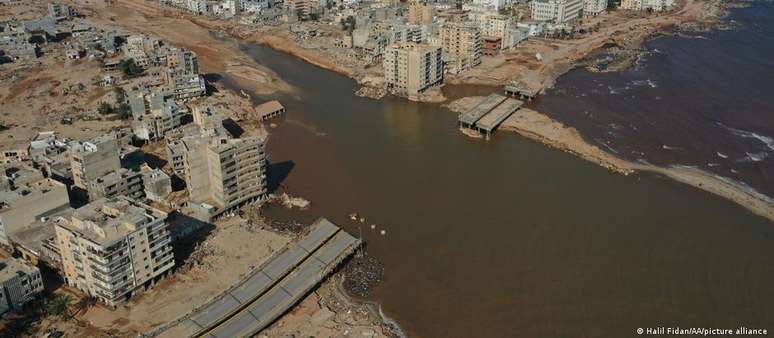Before the flood catastrophe, the eastern Libyan port city was known for its revolutionary spirit, Islamic extremism and privileged geographical location. Throughout its history, the Libyan coastal city of Derna has been both revered and feared. Founded at the end of the 15th century, on the site of a former Greek colony, it was a well-known center of intellectuality, independent thought, cosmopolitanism, art and culture.
With 100,000 inhabitants, it was also known for its attractive location on the Mediterranean coast, flanked by some of the arid country’s few forests.
Following recent catastrophic flooding, experts say the port city’s historic reputation and prime location were key contributing factors to even more deaths caused by Storm Daniel. To date there have been more than 11 thousand victims, as well as thousands missing.
Rebel city
In 2011, during the so-called Arab Spring, the people of Derna and the coastal city of Benghazi, 350 kilometers to the west, were among the first to protest against the country’s 42-year dictatorship.
For decades, the government of authoritarian leader Moammar Gaddafi has established a loyal power base in the west and around the capital Tripoli. He did not pay much attention to the East, long subjecting cities such as Derna and Benghazi to the effects of his policies of economic exclusion.
This is due, in part, to the fact that the people of Derna had expressed their opposition to Gaddafi since the beginning of his regime in the 1970s. His revolutionary reputation was forged by citizens who defended stricter versions of Islam, united by religious values, which ended up fighting against Gaddafi. In retaliation, the dictator brutalized Derna and left its infrastructure in ruins.
In the 1990s, men from Derna joined the Libyan Islamic Fighting Group (LIFG) militia, which led Gaddafi to impose a brutal crackdown on the city, sending soldiers going door-to-door hunting LIFG fighters.
The dictator also imposed punishments on the city, such as demolishing houses and cutting off water supplies. In 1996 many of the victims of the massacre that took place in a prison in Tripoli were originally from Derna. “The city has progressively eroded. There are no schools, the hospitals are in terrible condition and the infrastructure is neglected”, denounces the president of the National Council for US-Libya Relations, Hani Shennib.
A journalist from the British newspaper The Guardian who was in the city in 2011 observed that “Derna’s apartments and office buildings are dilapidated compared to the rest of the country; sewage leaks into the main streets.”
This neglect continued for years. Speaking to journalists, Hussein bin Dish, a local administration official, shouted that “nothing works here, there is no national authority, nothing”: “Look around you and do something about it. We live in a huge injustice.”
Hideout of Islamic extremists?
During the 2011 uprisings, Gaddafi often repeated that the protests in Derna had been fueled by Islamic extremists and groups such as Al Qaeda.
Experts, however, estimate that the city’s oppositional attitude derives only in part from the fact that it is a center of more conservative Islamic dissidents. The rebellion also stems from a long tradition of intelligentsia and counterculture.
After the end of the Gaddafi regime. In 2011, Derna, like the rest of Libya, was at the mercy of various guerrilla and militia groups, among which one of the most powerful in the city was the Abu Salim Martyrs’ Brigade, founded by a former LIFG member. In 2014, dissidents from this militia swore allegiance to the “Islamic State” (IS) group and took control of the city.
The jihadists’ rule “has largely been characterized by beheadings and other forms of execution or acts of public humiliation,” wrote Andrew McGregor, a Canadian expert on security issues in the Islamic world, in a 2018 report by the American think tank Jamestown Foundation.
Other groups in the city fought the Islamists, but only in 2016 was the city completely liberated from ISIS. However, unfortunately for the civilian population of Derna, the fighting did not end there.
Divided country
Libya has split in two since 2014, with rival governments located in the east and west, following the violent end of Gaddafi’s regime. The so-called national unity government, supported by the UN, is based in Tripoli in the west. Its eastern rival, known as the House of Representatives, is based in Tobruk.
Paramilitary leader Khalifa Haftar, whose Libyan National Army (LNA) controls most of the eastern half of the nation, also wanted rule over Derna. His forces besieged the city in 2015, but managed to take it only three years later.
The fighting in Derna was brutal. The international community, however, ignored the incident because it “had no objection to the elimination of this long-standing Islamic center,” McGregor says. Even after the violence ends in 2018, Derna will continue to be ignored and neglected by those in power in eastern Libya due to its reputation as a rebel stronghold.
“Libyans are shocked and blame corrupt governments that compete for power instead of governing, as well as diverting resources that should be invested in the reconstruction of Derna after the 2018 war, ignoring warnings about the dam situation,” wrote Tarek Megerisi , Political Director of the Middle East and North Africa Program at the European Council on Foreign Relations.
In early September, municipal elections in Derna were annulled, which allowed the LNA to remain in power, as Anas El Gomati, director of the Libyan think tank Sadeq Institute, noted.
“The local elections that should have taken place weeks ago in Derna were canceled in favor of the military [que ainda permanecerão] in power for another five years.”
“But what have they done in the last five years besides plunder the economy, destroy the city and sell the scrap for $1 billion?” he asked, referring to a 2019 report by the Global Initiative Against Organized Crime Transnacional, which investigated the LNA’s sources of funding.
The landscape contributed to the catastrophe
The city’s location was also a factor in the devastation caused by the floods. Pervaded by ancient churches and mosques, famous for its agriculture and bordered by beaches, Derna is built on what is called an alluvial fan – where the land is formed at the foot of mountains by the sediments of rivers and streams that flow into the sea. The city is divided in two by a river which remains dry for most of the year.
This type of geography is prone to floods, such as those Derna has faced several times in recent decades. In 1941, during World War II, a flood swept away German tanks and soldiers stationed on the outskirts of the city. Other major floods occurred in 1956, 1959, 1968 and 1986. The 1959 flood was the most severe, to be surpassed in 2023.
Regular flooding is precisely why Derna has two dams, Mansour and Derna, built in 1973 and 1977 by the Hidrotehnika-Hidroenergetika company, from the former Yugoslavia. According to the company, they functioned as a kind of flood and soil erosion control and provided irrigation to the plantations.
Until recently, the last flood in Derna was in 2011, after local authorities unsuccessfully attempted to drain water from the dams. But even before that it was clear to the population that the dams had not been properly maintained for years.
It is not known for certain when the last time they were monitored was. It could have been in 2022, or even 1983, judging by the statements of local residents to journalists. “For weeks, or rather years, we warned the authorities that the dams had cracks and needed maintenance. We spoke and no one listened to us. Now Derna is flooded”, comments a resident.
The city grew unplanned and haphazardly, buildings were built or expanded in areas where regular flooding had previously occurred. However, the dams gave residents a false sense of security.
But when the harsh reality of flooding presented itself in recent days, it wasn’t simply a matter of lack of maintenance. Hydrology experts assessed that the dams were not designed to withstand large volumes of rainfall, having been built before the effects of climate change became a reality.
Source: Terra
Rose James is a Gossipify movie and series reviewer known for her in-depth analysis and unique perspective on the latest releases. With a background in film studies, she provides engaging and informative reviews, and keeps readers up to date with industry trends and emerging talents.







